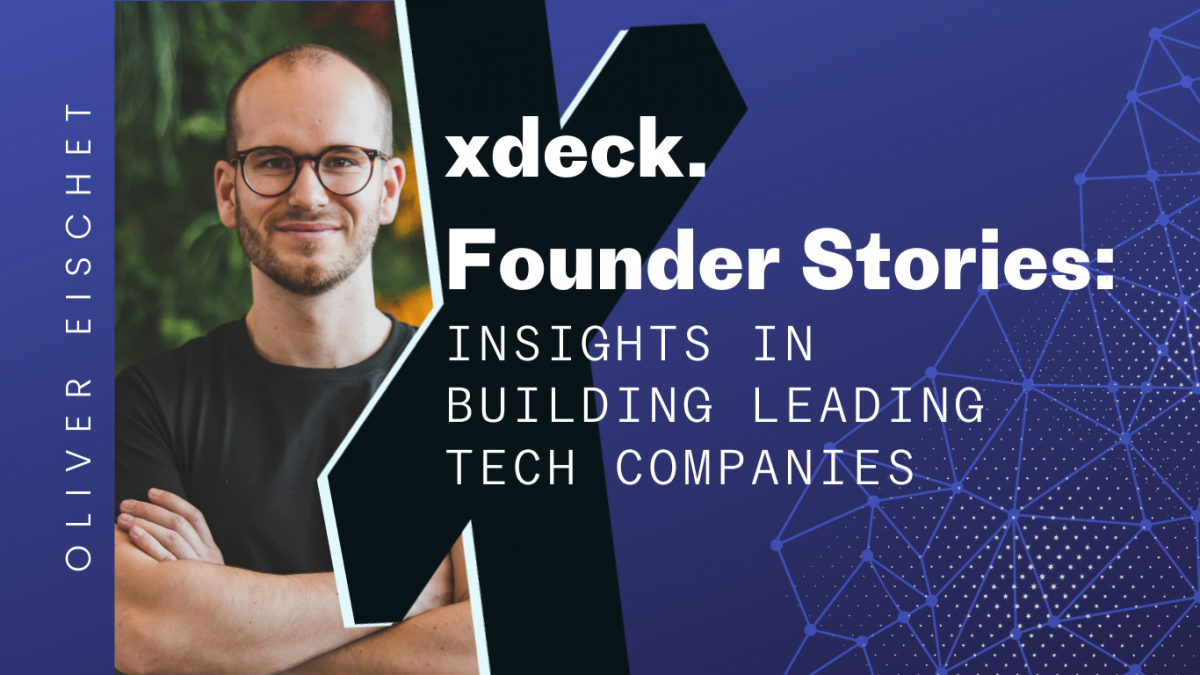
xdeck Founder Stories:
Insights in Building Leading Tech Companies

1. Could you give us an overview of specter automation and its mission in the construction industry?
Our mission with specter is to develop a software that serves every construction site in the world to ultimately better plan construction projects and keep them within time and budget constraints.
Let me start with myself, I'm Oliver Eischet and I'm originally not from the construction industry. I grew up in Aachen in an entrepreneurial family and gained my first founding experience at the age of 14, back then as part of the German founder competition for pupils. After high school, I moved on to Germany’s “founder forge”, WHU – Otto Beisheim School of Management. However, I didn't feel I had the perfect team, idea, and market, so I decided to continue my studies with a Master’s Degree in Business Administration from University St. Gallen, Switzerland. During that time, the first summer of the COVID-19 pandemic, I coincidentally ran into my best friend from kindergarten, Max. He grew up on the construction site and had been involved in software development and autonomous driving in Silicon Valley for several years after graduating from RWTH Aachen.
We started experimenting with crane automation technology but after a period of trial and error, we discovered this wasn’t what excited people in the industry. We realized we needed to get out into the field, onto construction sites, and we found a major challenge in the construction industry: the data gap between project planning in the office and execution on the construction site.
2. What inspired you and your co-founders to found specter automation in 2021?
While I was in Munich with my co-founders Niklas and Manu from WHU, we were joined by Mo, a university friend of Max's. Together, we explored use cases for the construction industry. We followed the Lean Startup methodology, we engaged in conversations with construction companies, crane manufacturers, and experts, confirming that the topic was interesting but perhaps 10-15 years ahead of its time. Realizing the need to immerse ourselves further, I even undertook a three-month internship as a construction manager. Recognizing our knowledge gaps, we prioritized co-creation and collaborated with industry veterans, ultimately partnering with three heterogenous construction companies. Through our external innovation perspective, we developed software and embarked on our first pilot project—a warehouse and logistics hall—resulting in gradual expansion from there. Our journey was one of collaboration and immersion, unveiling the vast potential of the construction sector, the world's second-largest yet second-least digitized industry.
3. The construction industry is facing significant pressure to modernize. In what ways does specter automation's software platform contribute to digitizing and improving efficiency in construction sites?
What we do with specter is essentially to digitize the heart of every construction site. That includes lookahead planning, determining what happens when, by whom, with what material, and at what time for the upcoming weeks. These are the core challenges that every construction manager around the world must address. Some make mental notes, while others use more sophisticated methods like agile boards or simple lists. Everyone needs some form of structuring. With us, everything happens digitally with the 3D model and, most importantly, with data. That's the data gap I mentioned earlier.
With us, users simply click on the components or areas in the 3D model that need to be planned, and we provide all the information needed to plan accurately. This includes what materials are needed for which tasks, how long they will take, and what costs are involved. The beauty of this is that planning becomes not only much more precise, but we can also use the data to automate recurring tasks that occur daily or weekly. Meanwhile, we provide all project stakeholders with a very clear, transparent database, showing where we currently stand with the construction project, what is planned next, and whether we will meet our planned end date or if there are already deviations that require early intervention.
5. The construction market in Germany is particularly suffering, which is why you have started first projects in the Scandinavia and Japan. Can you share how you manage the challenges of such early internationalization? Which KPIs do you track to make sure that you stay on the right growth path?
We're handling international expansion the same way we initially approached Germany—opportunistically. This means we're not actively doing outbound sales to acquire customers there but rather going with customers who actively approach us and say, "Hey, we think you’re super interesting, we absolutely want to test your software." This gives us very good opportunities for validating the market and seeing if the product is well-received by an intrinsically motivated customer. We manage everything from Germany, even the five projects we currently started in Japan. We're considering having someone on-site there in the future to be closer to the market though. But for now, we make sure to have weekly check-ins with the customers to stay very close. Regular feedback-loops with customers are crucial for learning from them and ensuring project success.
6. How do you deal with extended sales cycles, and have you identified any best practices on how to push potential new customers towards the final decision of using specter?
The construction industry is often criticized for having long sales cycles, but it really depends. If you have the perfect customers, it can go very quickly, and we're talking about closing contracts after two months. It happens, but it's also possible to have several touchpoints with a customer for over two years.
So, what can we do about it? I believe the most important thing here is trust, word of mouth, and consistently proving that you're a must-have software. From day one, you must do good work because as big as the construction industry may be, everyone knows each other. They exchange information about software solutions, even if they are perceived as competitors.
It's essential for the software, or its marketing, to be backed by substantial evidence of its value. This can be demonstrated through on-site proof and quantified with case studies, supported by testimonials from both users and the companies they represent, enhancing authenticity and credibility. Subsequently, the more customers you have, the easier and faster it gets because of the trust you already built.
7. The current fundraising environment is still quite difficult, and we are seeing quite some insolvencies among startups. How do you plan to raise your next financing round in this market? Why is specter a good investment?
Especially now, not just in the VC landscape but also in the construction industry, we're experiencing a downturn, and I think the question one must always ask, is whether you're a vitamin or a painkiller. While the construction industry is going through its worst period in probably 50 years in Germany, we just had the best month in the company's history. This strongly demonstrates that we are a painkiller because the focus is currently on efficiency and predictability in construction projects. I mean, that's exactly the issue we solve. Additionally, since starting with interior construction, having previously only done shell construction, we now cover the entire on-site construction value chain, from excavation to handover, which further diversified our customer base. We're not just working with construction companies but increasingly with project supervisors, developers, and clients who benefit from this data. And speaking of data, that's actually what specter is all about. Over the past few years, we've built probably the most comprehensive database of construction processes because we have about 20,000 tasks in specter per construction project, allowing us to retroactively reconstruct and simulate these projects. We have very detailed, structured data at the task level, which helps us integrate various automation and AI use cases. And that will be the near future: driving construction processes data-driven and automated using AI. I believe we're better positioned for this than almost any startup in the entire industry.
8. Integration and interoperability are essential aspects of software solutions in the construction industry. How does specter automation ensure seamless integration with existing construction management systems? Which role does AI play in your product strategy?
Since we started, we've primarily focused on integration with planning data. The reason digitalization often fails in the construction industry is due to the gap between planning and execution. We solve this by integrating with any software that provides relevant execution data in the planning phase, such as 3D models, schedules, and costing data or bill of quantities. We've built various interfaces that allow us to bring data directly to the construction site. The next chapter we'll soon embark on is building integrations with various existing on-site software solutions that already exist, representing individual processes and integrating them into our operating system.
For our AI advancement we initiated a hackathon in December where all 13 developers were taken from daily operations for a week. Our goal was to integrate a chatbot, and we managed to set up a prototype in a week. Since January, we've been refining it, but our users can already chat with our software via text and voice commands. For example, say, "Hey specter, show me all the walls on the second floor," and the 3D model will filter to that area, providing the necessary data. This makes it easier for users to interact with the software since it's intuitive for them to communicate using language. This way, the software adapts to the user, executing what the user inputs.
9. Looking ahead, what are specter automation's plans, can you give us a sneak peek into upcoming features?
We have three pillars, which are of the highest priority for us in product development: integration, deliveries, and AI use cases.
We've already discussed integrations a bit. We also had a trial integration with a camera provider last year, which essentially detects processes on the construction site, and we are planning to feed that data into our system. However, we'll build many more integrations, for example, with quality and issue management systems, or tools that work a lot with photo and video recordings from the construction site.
The second aspect we'll cover is deliveries. With our software, you can already schedule deliveries and your weekly calendar. While we have all the data, such as from the 3D model, what we've yet to do is execute these deliveries. Essentially, you place orders for the necessary materials through us or an integrated system. Subsequently, we incorporate the estimated time of arrival (ETA) and delivery note data directly into the 3D model. This way, we can generate as-built data, showing how construction is progressing and which materials are being used, enabling sustainability analysis and many more.
The third topic is AI applications. Our grand vision is to guide construction managers on their next steps. They won't need to manually plan; instead, we offer automated task generation. This system suggests what should be planned and executed in the upcoming weeks to ensure project success. It's the ultimate goal of the construction industry. Achieving this could potentially elevate us to unicorn status in the industry.
Thank you for your time!

